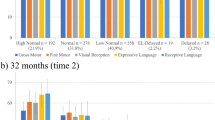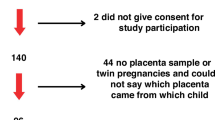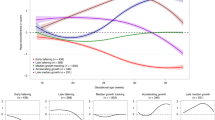Abstract
The objective of the study was to examine whether infant neuromotor development is determined by fetal size and body symmetry in the general population. This study was embedded within the Generation R Study, a population-based cohort in Rotterdam. In 2965 fetuses, growth parameters were measured in mid-pregnancy and late pregnancy. After birth, at age 9 to 15 wks, neuromotor development was assessed with an adapted version of Touwen's Neurodevelopmental Examination. Less optimal neuromotor development was defined as a score in the highest tertile. We found that higher fetal weight was beneficial to infant neurodevelopment. A fetus with a 1-SD score higher weight in mid-pregnancy had an 11% lower risk of less optimal neuromotor development (OR: 0.89; 95% CI: 0.82–0.97). Similarly, a fetus with a 1-SD score larger abdominal-to-head circumference (AC/HC) ratio had a 13% lower risk of less optimal neuromotor development (OR: 0.87; 95% CI: 0.79–0.96). These associations were also present in late pregnancy. Our findings show that fetal size and body symmetry in pregnancy are associated with infant neuromotor development. These results suggest that differences in infant neuromotor development, a marker of behavioral and cognitive problems, are at least partly caused by processes occurring early in fetal life.
Similar content being viewed by others
Log in or create a free account to read this content
Gain free access to this article, as well as selected content from this journal and more on nature.com
or
Abbreviations
- AC/HC:
-
abdominal-to-head circumference
- ICC:
-
Intraclass correlation coefficient
References
Samsom JF, de Groot L, Bezemer PD, Lafeber HN, Fetter WP 2002 Muscle power development during the first year of life predicts neuromotor behaviour at 7 years in preterm born high-risk infants. Early Hum Dev 68: 103–118
Davis NM, Ford GW, Anderson PJ, Doyle LW 2007 Developmental coordination disorder at 8 years of age in a regional cohort of extremely-low-birthweight or very preterm infants. Dev Med Child Neurol 49: 325–330
Pine DS, Wasserman GA, Fried JE, Parides M, Shaffer D 1997 Neurological soft signs: one-year stability and relationship to psychiatric symptoms in boys. J Am Acad Child Adolesc Psychiatry 36: 1579–1586
Whitaker AH, Feldman JF, Lorenz JM, Shen S, McNicholas F, Nieto M, McCulloch D, Pinto-Martin JA, Paneth N 2006 Motor and cognitive outcomes in nondisabled low-birth-weight adolescents: early determinants. Arch Pediatr Adolesc Med 160: 1040–1046
Barker DJ 1995 Fetal origins of coronary heart disease. BMJ 311: 171–174
St Clair D, Xu M, Wang P, Yu Y, Fang Y, Zhang F, Zheng X, Gu N, Feng G, Sham P, He L 2005 Rates of adult schizophrenia following prenatal exposure to the Chinese famine of 1959–1961. JAMA 294: 557–562
Susser E, Neugebauer R, Hoek HW, Brown AS, Lin S, Labovitz D, Gorman JM 1996 Schizophrenia after prenatal famine. Further evidence. Arch Gen Psychiatry 53: 25–31
Shenkin SD, Starr JM, Deary IJ 2004 Birth weight and cognitive ability in childhood: a systematic review. Psychol Bull 130: 989–1013
Pearce MS, Deary IJ, Young AH, Parker L 2005 Growth in early life and childhood IQ at age 11 years: the Newcastle Thousand Families Study. Int J Epidemiol 34: 673–677
Kirkegaard I, Obel C, Hedegaard M, Henriksen TB 2006 Gestational age and birth weight in relation to school performance of 10-year-old children: a follow-up study of children born after 32 completed weeks. Pediatrics 118: 1600–1606
Gale CR, O'Callaghan FJ, Godfrey KM, Law CM, Martyn CN 2004 Critical periods of brain growth and cognitive function in children. Brain 127: 321–329
Campbell S, Thoms A 1977 Ultrasound measurement of the fetal head to abdomen circumference ratio in the assessment of growth retardation. Br J Obstet Gynaecol 84: 165–174
Rasmussen S, Kiserud T, Albrechtsen S 2006 Foetal size and body proportion at 17–19 weeks of gestation and neonatal size, proportion, and outcome. Early Hum Dev 82: 683–690
Jaddoe VW, van Duijn CM, van der Heijden AJ, Mackenbach JP, Moll HA, Steegers EA, Tiemeier H, Uitterlinden AG, Verhulst FC, Hofman A 2008 The Generation R Study: design and cohort update until the age of 4 years. Eur J Epidemiol 23: 801–811
Hadlock FP, Harrist RB, Carpenter RJ, Deter RL, Park SK 1984 Sonographic estimation of fetal weight. The value of femur length in addition to head and abdomen measurements. Radiology 150: 535–540
Verburg BO, Mulder PG, Hofman A, Jaddoe VW, Witteman JC, Steegers EA 2008 Intra- and interobserver reproducibility study of early fetal growth parameters. Prenat Diagn 28: 323–331
de Beurs E 2004 Brief Symptom Inventory, Handleiding. Pits Publishers, Leiden, The Netherlands
O'Connor TG, Heron J, Glover V 2002 Antenatal anxiety predicts child behavioral/emotional problems independently of postnatal depression. J Am Acad Child Adolesc Psychiatry 41: 1470–1477
Touwen B 1976 Neurological Development in Infancy. Mac Keith Press, London, pp 28–126
van Batenburg-Eddes T, de Groot L, Huizink AC, Steegers EA, Hofman A, Jaddoe VW, Verhulst FC, Tiemeier H 2009 Maternal symptoms of anxiety during pregnancy affect infant neuromotor development: The Generation R Study. Dev Neuropsychol 34: 476–493
Cohen J 1968 Weighted kappa; nominal scale agreement with provision for scaled disagreement or partial credit. Psychol Bull 70: 213–220
Peters LH, Maathuis KG, Kouw E, Hamming M, Hadders-Algra M 2008 Test-retest, inter-assessor and intra-assessor reliability of the modified Touwen examination. Eur J Paediatr Neurol 12: 328–333
Mickey RM, Greenland S 1989 The impact of confounder selection criteria on effect estimation. Am J Epidemiol 129: 125–137
Prechtl HF 1977 The Neurological Examination of the Full-term Newborn Infant. Cambridge University Press, London, pp 1–8
Touwen BC 1979 Examination of the child with minor neurological dysfunction Clinics in Developmental Medicine. 2nd ed. William Heinemann Medical Books, London
Rice D, Barone S Jr 2000 Critical periods of vulnerability for the developing nervous system: evidence from humans and animal models. Environ Health Perspect 108: 511–533
Harvey D, Prince J, Bunton J, Parkinson C, Campbell S 1982 Abilities of children who were small-for-gestational-age babies. Pediatrics 69: 296–300
Hoff Esbjorn B, Hansen BM, Greisen G, Mortensen EL 2006 Intellectual development in a Danish cohort of prematurely born preschool children: specific or general difficulties?. J Dev Behav Pediatr 27: 477–484
Mikkola K, Ritari N, Tommiska V, Salokorpi T, Lehtonen L, Tammela O, Paakkonen L, Olsen P, Korkman M, Fellman V 2005 Neurodevelopmental outcome at 5 years of age of a national cohort of extremely low birth weight infants who were born in1996–1997. Pediatrics 116: 1391–1400
Widdowson EM, McCance RA 1975 A review: new thoughts on growth. Pediatr Res 9: 154–156
McCance RA, Widdowson EM 1974 The determinants of growth and form. Proc R Soc Lond B Biol Sci 185: 1–17
Huizink AC, Robles de Medina PG, Mulder EJ, Visser GH, Buitelaar JK 2003 Stress during pregnancy is associated with developmental outcome in infancy. J Child Psychol Psychiatry 44: 810–818
Griffiths LJ, Dezateux C, Cole TJ 2007 Differential parental weight and height contributions to offspring birthweight and weight gain in infancy. Int J Epidemiol 36: 104–107
Knight B, Shields BM, Turner M, Powell RJ, Yajnik CS, Hattersley AT 2005 Evidence of genetic regulation of fetal longitudinal growth. Early Hum Dev 81: 823–831
Peter I, Vainder M, Livshits G 1999 Genetic analysis of motor milestones attainment in early childhood. Twin Res 2: 1–9
Duncan KR, Issa B, Moore R, Baker PN, Johnson IR, Gowland PA 2005 A comparison of fetal organ measurements by echo-planar magnetic resonance imaging and ultrasound. BJOG 112: 43–49
Scherjon S, Briet J, Oosting H, Kok J 2000 The discrepancy between maturation of visual-evoked potentials and cognitive outcome at five years in very preterm infants with and without hemodynamic signs of fetal brain-sparing. Pediatrics 105: 385–391
Acknowledgements
The Generation R Study is conducted by the Erasmus Medical Center, Rotterdam in close collaboration with the School of Law and Faculty of Social Sciences of the Erasmus University Rotterdam, the Municipal Health Service Rotterdam area, the Rotterdam Homecare Foundation, and the Stichting Trombosedienst and Artsenlaboratorium Rijnmond (STAR), Rotterdam. We acknowledge the contribution of participating mothers and their children, general practitioners, hospitals, midwives, and pharmacies in Rotterdam.
Author information
Authors and Affiliations
Corresponding author
Additional information
The first phase of the Generation R Study is made possible by financial support from the Erasmus Medical Center, Rotterdam, the Erasmus University Rotterdam, and the Netherlands Organization for Health Research and Development (Zon Mw). The present study was supported by a grant from the Sophia Children's Hospital Foundation (project number 443).
Rights and permissions
About this article
Cite this article
van Batenburg-Eddes, T., de Groot, L., Steegers, E. et al. Fetal Programming of Infant Neuromotor Development: The Generation R Study. Pediatr Res 67, 132–137 (2010). https://doi.org/10.1203/PDR.0b013e3181c2dc76
Received:
Accepted:
Issue date:
DOI: https://doi.org/10.1203/PDR.0b013e3181c2dc76
This article is cited by
-
Taurine supplementation improves hippocampal metabolism in immature rats with intrauterine growth restriction (IUGR) through protecting neurons and reducing gliosis
Metabolic Brain Disease (2022)
-
The Effect of Size and Asymmetry at Birth on Brain Injury and Neurodevelopmental Outcomes in Congenital Heart Disease
Pediatric Cardiology (2022)
-
Neurodevelopmental effects of prenatal vitamin D in humans: systematic review and meta-analysis
Molecular Psychiatry (2020)
-
Fetal Growth and Neurodevelopmental Outcome in Congenital Heart Disease
Pediatric Cardiology (2015)
-
Somatic growth trajectory in the fetus with hypoplastic left heart syndrome
Pediatric Research (2013)



